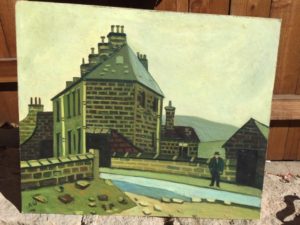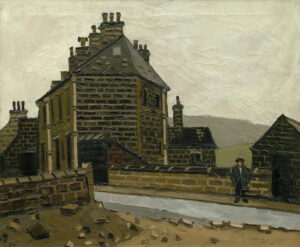 In Winter of 2020 LS wrote me that he purchased a nineteen by fifteen-and-a-half inch painting. A note on the back said, “Attributed to Kyffin Williams 1918-2006, British.” LS found it for $40 in a junk shop in upstate New York. He sent me photos at the time and asked if I thought Williams, the great national artist of Wales, painted it. Lately, a US Auction House sold a Williams seascape estimated between $13K and $20K. Sotheby’s sold a street scene for $50K.
In Winter of 2020 LS wrote me that he purchased a nineteen by fifteen-and-a-half inch painting. A note on the back said, “Attributed to Kyffin Williams 1918-2006, British.” LS found it for $40 in a junk shop in upstate New York. He sent me photos at the time and asked if I thought Williams, the great national artist of Wales, painted it. Lately, a US Auction House sold a Williams seascape estimated between $13K and $20K. Sotheby’s sold a street scene for $50K.
One can do the research I undertook with ANY painting that might originate from a fine artist.
Research the Artist’s Background
Art historians regard Williams as the defining presence in 20th century Welsh art, so it’s sad that the back says British and not WELSH. Our first clue that the painting is not original. Anyone with any contact with Williams’s oeuvre would write WELSH. Although he taught in England for thirty years as a painting master, he retired at Pwllfanogl, Llanfairpwll, on the Isle of Anglesey, near the Menai Straits overlooking Snowdonia, close to his birthplace.
He became a professional artist late in life. In the British Army he suffered from an epileptic fit and they told him he should continue painting instead.
Later, after he won the Winston Churchill Fellowship, he traveled to Patagonia to paint the Welsh settlement of Y Wladfa. He was awarded the OBE, then knighted in 1999.
The National Library of Wales in Aberystwyth holds a major selection of his works. He wrote: (no other country) “touches the mood…of melancholy that is in most Welshmen, a melancholy derived from the dark hills, the heavy clouds, and the enveloping sea mist.” This also gives a clue: HOW the artist reflected on what painted tells us that he loved the ominous greys of that Welsh sky. He admired the working class grit and industrialism of the place. We find another clue in the WAY an artist signs: this egalitarian artist signed with his initials throughout his career. Williams died a wealthy man and gave much to art charitable causes in Wales.
He knew the Welsh landscape so well that when he painted a mountain, he knew what sat on the other side. He didn’t consider painting about making images, his creative process involved sympathy. To him, to communicate, one must understand and feel the image. He said obsession was a greater asset than talent and he became prolific with a palette knife in all weather. Another clue: a palette knife gives a painting broad thick area of paint.
LS’s painting contains some hallmarks. It depicts a Welsh industrial scene, certain colors of the grey cold climate, the hard edge of stone, and a palette knife technique. And indeed, signed KW.
How to authenticate this painting?
Williams sold through galleries; museums collected his works. I researched the galleries. I tried Oriel Ynysmon, in Williams’s town of Llangefni, and emailed a photo. They told me to get in touch with the Rogers Jones Auction House in Wales. A number of galleries once sold his paintings. Three were particularly prominent, the Tegfryn Gallery in Menai Bridge (since 1968), the Thackeray Gallery in London (since 1975), and the Albany Gallery in Cardiff (since 1975). Mary Yapp, the owner of the Albany, acted as his agent. Oriel Plas Glyn y Weddw in Llanbedrog sold. But these galleries no longer sell regularly, and most colleagues are now gone. His work remains in many galleries throughout Britain and overseas. The majority of the thousands of pictures he painted during his lifetime reside in private collections. Galleries or Auction Houses are the way to go because museums usually can’t offer opinions.
The National Library of Wales in Aberystwyth held a retrospective to honor the centenary of his birth (1918) in 2018. So I emailed a photo to the director, Lona Mason. I also contacted David Wynn Meredith, chair of the Sir Kyffin Williams Trust. These experts got me close to answering questions of authenticity. Everyone said to write directly to BEN ROGERS JONES, Auctioneer, Rogers Jones & Co, Cardiff, Wales. Go to the country of origin and FIND the expert who SELLS.
 Ben was kind enough to look at LS’s painting, the “greener” painting above; Ben sent me back a painting he sold, the GREYER one. Ben deemed PS’s a copy, but to make sure we needed to send him the painting.
Ben was kind enough to look at LS’s painting, the “greener” painting above; Ben sent me back a painting he sold, the GREYER one. Ben deemed PS’s a copy, but to make sure we needed to send him the painting.
I contrast the two paintings in the photos: LS’s lacks the GRIT of the other painting. LS’s lacks the DEPTH. LS’s lacks the subtle gradation of hue and value, depth of color. Williams painted to evoke emotion, LS’s painting lacks emotion!
If you think you have an original painting, see if you can find the SAME IMAGE in a museum or sold at auction. If you do, you are 80 percent of the way to certainty that you have a COPY. But not always, as artists DO make oil studies!